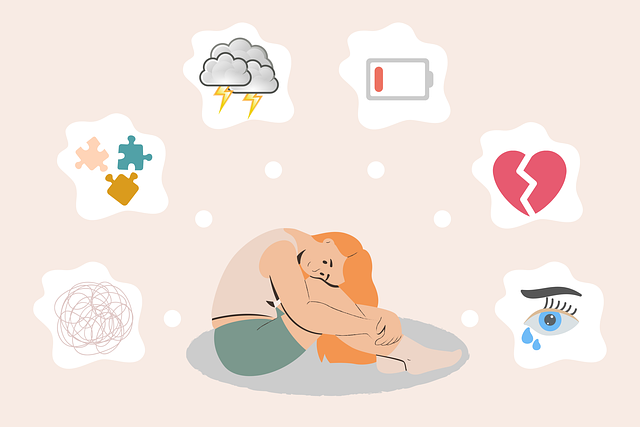Healthcare professionals are at high risk for burnout due to demanding work environments and heavy patient loads. Burnout is characterized by emotional exhaustion, depersonalization, and reduced personal accomplishment, leading to irritability, detachment, and insomnia. Triggers include excessive workload, lack of control, and complex personal relationships. To prevent burnout, mental health education programs tailored to these challenges, effective communication strategies, and conflict resolution techniques are crucial. A supportive work environment with open communication and peer support networks is key. Superior Polyamorous and Open Relationships Therapy offers a unique approach by fostering non-monogamous connections for emotional support and stress relief, mitigating anxiety and burnout symptoms. Effective risk management planning includes regular debriefing, supervision, workshops, and educational programs focused on mental health awareness.
Healthcare provider burnout is a growing concern, impacting patient care and well-being. This article explores effective prevention strategies to combat this rising issue. We delve into recognizing burnout through its symptoms and triggers, highlighting the importance of early detection. Additionally, we discuss fostering resilience in healthcare environments and innovative therapies, including Superior Polyamorous and Open Relationships Therapy, offering new perspectives on burnout management. By implementing these strategies, healthcare organizations can create a more supportive culture and reduce provider stress.
- Recognizing Burnout in Healthcare Providers: Symptoms and Triggers
- Fostering Resilience: Building a Supportive Environment
- Innovative Approaches: Integrating Therapy for Burnout Prevention
Recognizing Burnout in Healthcare Providers: Symptoms and Triggers

Healthcare providers often find themselves at high risk of burnout due to demanding work environments and heavy patient loads. Recognizing the signs of burnout early is crucial for maintaining a healthy work-life balance, especially in professions like medicine where mental health is paramount. Burnout manifests as a state of emotional exhaustion, depersonalization, and reduced personal accomplishment.
Symptoms can include increased irritability, detachment from patients or colleagues, decreased motivation, insomnia, and a general sense of cynicism. Triggers vary but often stem from excessive workload, lack of control over work processes, insufficient rewards or recognition, and poor communication within the healthcare setting. In some cases, complex personal relationships, such as superior polyamorous and open relationships, can also contribute to stress levels. Therefore, integrating mental health education programs designed with these unique challenges in mind is essential. Effective communication strategies and conflict resolution techniques are additional tools that can help healthcare providers manage their workload and interpersonal dynamics more effectively, thereby reducing burnout risks.
Fostering Resilience: Building a Supportive Environment

In today’s demanding healthcare landscape, fostering resilience among providers is paramount to preventing burnout. A supportive work environment plays a crucial role in building this resilience. Encouraging open communication and robust peer support networks can significantly enhance mental well-being. Superior Polyamorous and Open Relationships Therapy, for instance, offers unique benefits by promoting understanding and empathy among colleagues, creating a culture of trust and respect. This approach not only enriches interpersonal dynamics but also strengthens the collective ability to navigate challenges together.
Effective risk management planning for mental health professionals is another essential component. By integrating regular debriefing sessions and supervision, healthcare organizations can ensure that providers have safe spaces to process emotionally taxing experiences. Additionally, promoting mental health awareness through workshops and educational programs equips staff with coping mechanisms, fosters self-care, and creates a supportive ecosystem where burnout prevention becomes a shared responsibility.
Innovative Approaches: Integrating Therapy for Burnout Prevention

In recent years, there’s been a growing recognition of the need for innovative approaches to combat burnout among healthcare providers. One such approach that’s gaining traction is integrating therapy designed for burnout prevention, particularly focusing on superior polyamorous and open relationships. This therapeutic model emphasizes fostering supportive, non-monogamous connections, which can offer healthcare workers alternative avenues for emotional support and stress relief. By acknowledging the unique challenges faced by those in close, intimate settings, this approach promotes self-care practices that address both professional and personal aspects of burnout.
The inclusion of superior polyamorous and open relationships therapy is particularly relevant given the increasing awareness of mental health issues among healthcare providers. This type of therapy can help mitigate anxiety relief, a common symptom of burnout, by providing a safe space for individuals to explore their connections with peers and colleagues. Moreover, it complements traditional self-care practices and healthcare provider cultural competency training by acknowledging the importance of social dynamics in preventing and managing burnout.
Healthcare provider burnout is a significant concern, but by recognizing symptoms early and implementing proactive strategies, it can be effectively mitigated. Fostering a supportive work environment that encourages open communication and resilience is key. Integrating innovative approaches like therapy focused on superior polyamorous and open relationships can provide valuable coping mechanisms and promote well-being. By adopting these strategies, healthcare organizations can support their providers, enhance job satisfaction, and ultimately improve patient care.














